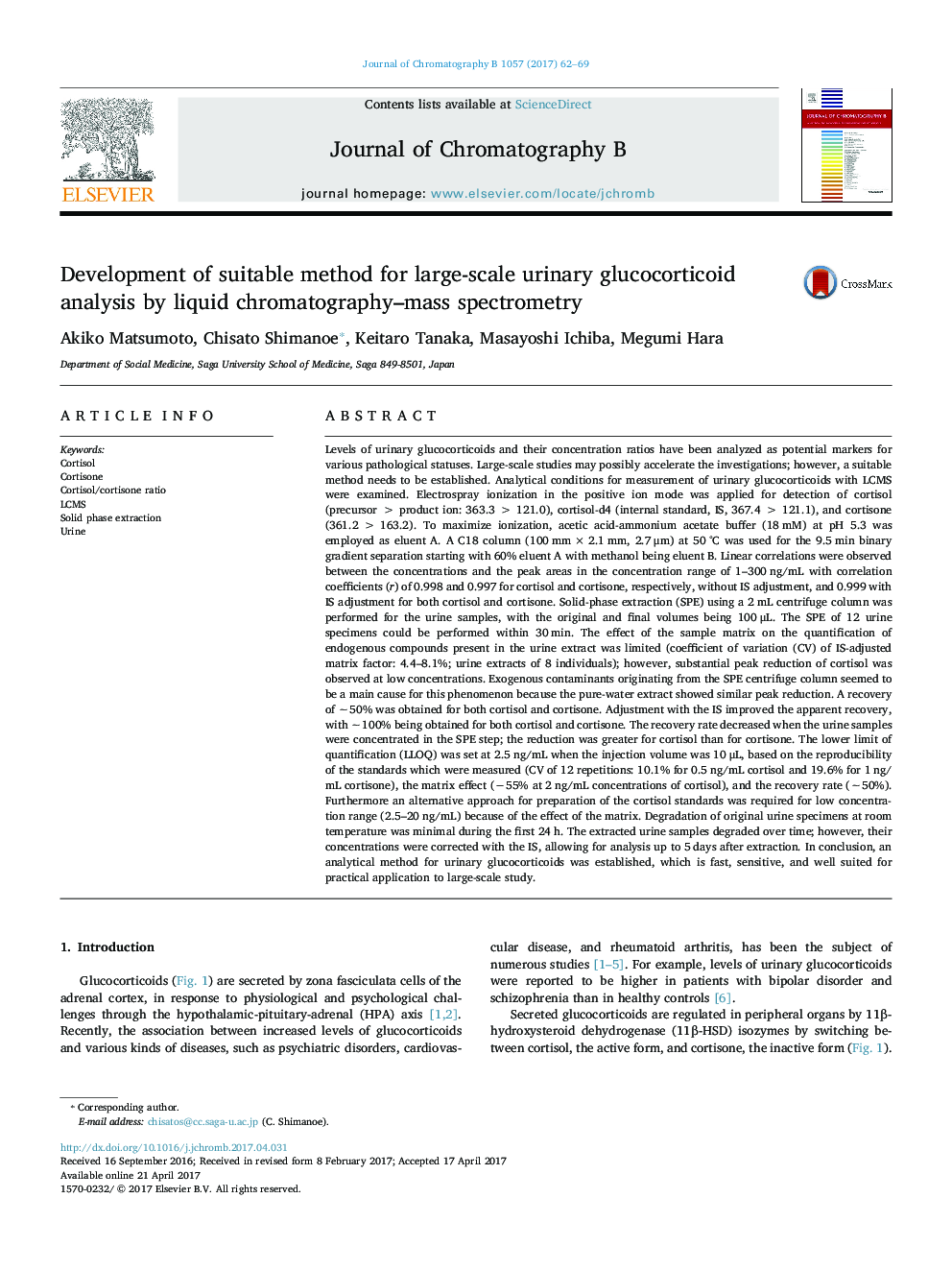| کد مقاله | کد نشریه | سال انتشار | مقاله انگلیسی | نسخه تمام متن |
|---|---|---|---|---|
| 5136272 | 1494006 | 2017 | 8 صفحه PDF | دانلود رایگان |

- The method is applicable and well-prepared for large-scale study.
- 12 urine samples (100 μL each) are extracted within 30 min.
- The LLOQ for cortisol and cortisone was 2.5 ng/mL (injection volume: 10 μL).
- Minimal degradation of urine samples at room temperature during first 24Â h.
- The extracted urine samples are quantifiable for up to 5Â days after extraction.
Levels of urinary glucocorticoids and their concentration ratios have been analyzed as potential markers for various pathological statuses. Large-scale studies may possibly accelerate the investigations; however, a suitable method needs to be established. Analytical conditions for measurement of urinary glucocorticoids with LCMS were examined. Electrospray ionization in the positive ion mode was applied for detection of cortisol (precursor > product ion: 363.3 > 121.0), cortisol-d4 (internal standard, IS, 367.4 > 121.1), and cortisone (361.2 > 163.2). To maximize ionization, acetic acid-ammonium acetate buffer (18 mM) at pH 5.3 was employed as eluent A. A C18 column (100 mm Ã 2.1 mm, 2.7 μm) at 50 °C was used for the 9.5 min binary gradient separation starting with 60% eluent A with methanol being eluent B. Linear correlations were observed between the concentrations and the peak areas in the concentration range of 1-300 ng/mL with correlation coefficients (r) of 0.998 and 0.997 for cortisol and cortisone, respectively, without IS adjustment, and 0.999 with IS adjustment for both cortisol and cortisone. Solid-phase extraction (SPE) using a 2 mL centrifuge column was performed for the urine samples, with the original and final volumes being 100 μL. The SPE of 12 urine specimens could be performed within 30 min. The effect of the sample matrix on the quantification of endogenous compounds present in the urine extract was limited (coefficient of variation (CV) of IS-adjusted matrix factor: 4.4-8.1%; urine extracts of 8 individuals); however, substantial peak reduction of cortisol was observed at low concentrations. Exogenous contaminants originating from the SPE centrifuge column seemed to be a main cause for this phenomenon because the pure-water extract showed similar peak reduction. A recovery of â¼50% was obtained for both cortisol and cortisone. Adjustment with the IS improved the apparent recovery, with â¼100% being obtained for both cortisol and cortisone. The recovery rate decreased when the urine samples were concentrated in the SPE step; the reduction was greater for cortisol than for cortisone. The lower limit of quantification (LLOQ) was set at 2.5 ng/mL when the injection volume was 10 μL, based on the reproducibility of the standards which were measured (CV of 12 repetitions: 10.1% for 0.5 ng/mL cortisol and 19.6% for 1 ng/mL cortisone), the matrix effect (â55% at 2 ng/mL concentrations of cortisol), and the recovery rate (â¼50%). Furthermore an alternative approach for preparation of the cortisol standards was required for low concentration range (2.5-20 ng/mL) because of the effect of the matrix. Degradation of original urine specimens at room temperature was minimal during the first 24 h. The extracted urine samples degraded over time; however, their concentrations were corrected with the IS, allowing for analysis up to 5 days after extraction. In conclusion, an analytical method for urinary glucocorticoids was established, which is fast, sensitive, and well suited for practical application to large-scale study.
Journal: Journal of Chromatography B - Volume 1057, 1 July 2017, Pages 62-69